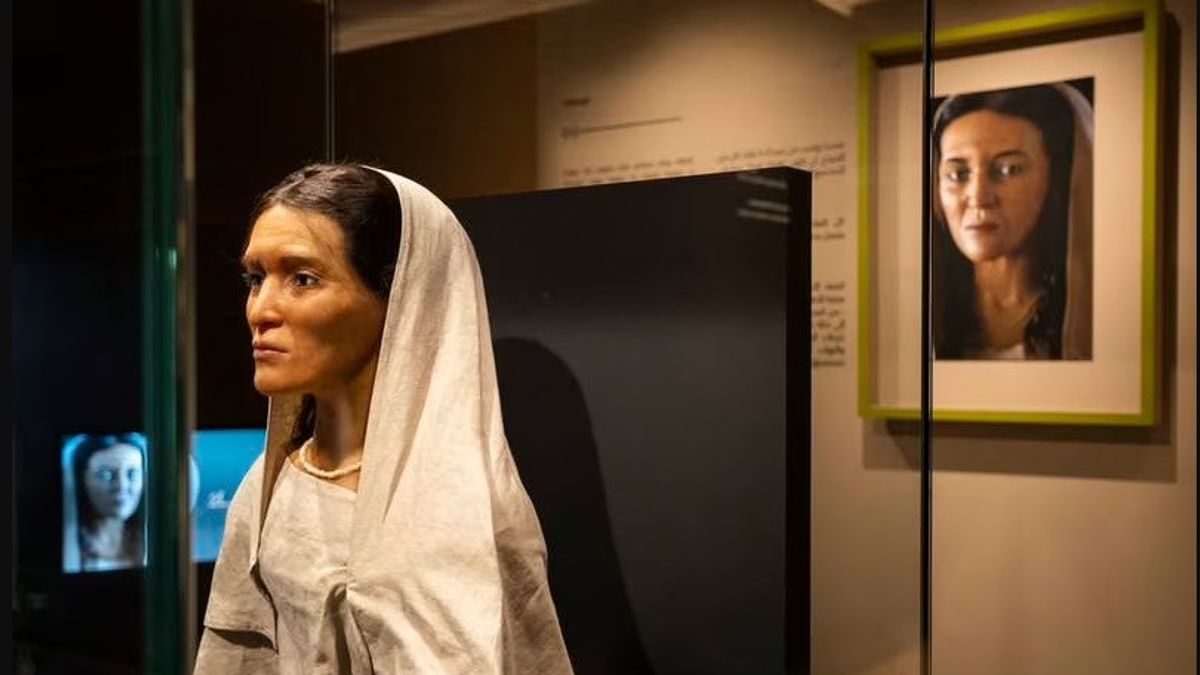JAKARTA - The extraordinary physical reconstruction of a Nabataean woman who lives on the Arab peninsula more than 2,000 years ago has been on display to the public.
Hinat, as the name suggests, is represented as a live human statue made of silicon, with piercingd ears and artificial hair individually intertwined to the skin of its head.
It looks amazing, Hinat was created through a complex process that combines expert scientific input with artistic talent.
She is a real person, becoming a prominent woman who is one of 80 people, some of them may be linked, found in a monumental tomb on the UNESCO World Heritage site in Hegra, northwest of Saudi Arabia.
omist Chapman, an expert on the narrative experience at the Royal Commission for Al Ula, the Saudi Arabian organization behind the project said Hinat should allow people to see the more human side of the Nabataean Tribe, which is a nomadic Bedouin in the Arab Desert.
"What's really interesting is that when we think about the Nabataean tribe, we think about monuments and we think about these scale and architectural achievements," he explained as reported by The National News on February 6.
"What this project makes possible for us to do is narrow it down to individuals, which gives us insight in very different ways," he said.
"This tells us that Hegra is not just a place for graves, but a place to live where people live, work and die. It's great to be reminded," he said.
Hinat is thought to be over 45, suffering from osteoarthritis, possibly having a mild bifide spina and her teeth are in bad shape.
His almost completed framework, in 2008 was excavated from Hegra's tomb, where work has been led by the Mada'in Salih Archaeological Project since 2002.
Experts such as archaeologists, forensic scientists, anthropologists and model makers are working to produce Hinat reconstruction.
A one-day discussion involving experts was held to help decide, for example, what kind of clothes, hair and jewelry would be like.
"We thought reconstructing faces would be a very extraordinary way to engage an audience and bring the story of Nabataeans to life," explains Dr. Helen McGauran, an expert in heritage curatorial at the Royal Commission for Al Ula, which developed the northwestern region of Saudi, the AlUla region as a cultural and tourist destination.
Reconstruction resulted in "emotional reactions" even among experts, said Dr. McGauran, with one of his colleagues experiencing "satisfaction and a little forgetness" when he saw the reconstruction.
"I don't think you can describe it as art or science," said Dr. McGauran about the reconstruction project.
"It's about the marriage between the two. It's very informed by... an ethical approach with respect to human bodies and reflecting itself as a person."
Hinat, whose eyeball is made of glass, is considered the first Nabataean woman to have her face reconstructed.
Because the project involved human remains, Dr. McGauran said the work, including scanning his skull, was carried out in an honorable manner.
Those involved must grapple with a lack of genetic data and lack of information, such as about the muscles and skin of the Nabataean people, from the strains present in contemporary society.
There are no immediate plans to produce more facial reconstruction, but organizers say this could happen, either for Nabatanean or members of other groups.
In the tomb where Hinat was found, there is an inscription that reads: "This is a tomb made by Wahbu's daughter Hinat for herself and her children and descendants for good."
This inscription directed those working on the project to name him Hinat the person who became the basis of the statue, but unlikely he was the Hinat mentioned in the tomb.
It is known that Hegra City, where the tomb is located, is the center of the tobacco trade route, which covers areas such as the Mediterranean, North Africa, the Arabian peninsula, and India.
Under Nabataean, Hegra, in the first century of BC, surpassed Dadan nearby, another point on the trade route, according to the Royal Commission for Al Ula.
Hinat was installed at the Hegra Welcome Center, Hegra archaeological site on January 31 and he was on display to the public starting February 6.
In 2008, Hegra became the first World Heritage site in Saudi Arabia. UNESCO quotes at the time described the site as an "extraordinary witness to the important cultural exchange in the architecture, use of language and trading of the flagship".
The English, Chinese, Japanese, Arabic, and French versions are automatically generated by the AI. So there may still be inaccuracies in translating, please always see Indonesian as our main language. (system supported by DigitalSiber.id)













